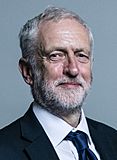2016 Labour Party leadership election (UK) facts for kids
|
|||||||||||||
| Turnout | 506,438 (77.6%) |
||||||||||||
|---|---|---|---|---|---|---|---|---|---|---|---|---|---|
|
|||||||||||||
|
|||||||||||||
The 2016 Labour Party leadership election was a special vote to decide who would lead the Labour Party in the United Kingdom. This election happened because some people in the party were not happy with Jeremy Corbyn's leadership.
The main reason for the challenge was how he handled the campaign about whether the UK should stay in or leave the European Union. People also had questions about his overall leadership of the party.
The results were announced on 24 September 2016. Jeremy Corbyn won the election. He received 313,209 votes, which was 61.8% of all votes. This was even more votes and a higher percentage than he got in the previous leadership election in 2015.
Contents
Who Can Be a Party Leader?
To become the leader of a political party like Labour, a person usually needs to be a Member of Parliament (MP). They also need support from other MPs and sometimes from party members or groups.
What is a Leadership Election?
A leadership election is when members of a political party vote to choose their leader. This is important because the party leader often becomes the country's Prime Minister if their party wins the general election.
The Candidates in 2016
In the 2016 Labour leadership election, there were two main candidates: Jeremy Corbyn and Owen Smith.
Jeremy Corbyn: The Incumbent Leader
Jeremy Corbyn was already the leader of the Labour Party. He had been an MP for Islington North since 1983. As the leader of the Labour Party, he was also the Leader of the Opposition. This means he was the main person challenging the government in power.
- Born: 26 May 1949
- Role: Leader of the Labour Party and Leader of the Opposition
- Slogan: "People powered politics"
Jeremy Corbyn received support from many local Labour Party groups, called Constituency Labour Parties (CLPs). He also had the backing of several large trade unions, which are groups that represent workers.
Owen Smith: The Challenger
Owen Smith was the other candidate who challenged Jeremy Corbyn for the leadership. He was an MP for Pontypridd since 2010. Before running for leader, he was a "Shadow Secretary of State." This role means he was in charge of a specific area (like Work and Pensions) for the opposition party.
- Born: 2 May 1970
- Role: MP for Pontypridd
- Slogan: "Labour's Future"
Owen Smith also received support from many MPs and some local Labour Party groups. He was also supported by some trade unions and other Labour-affiliated groups.
How the Election Worked
The election was open to different groups of people:
- Full Members: People who had been full members of the Labour Party for at least six months.
- Affiliated Supporters: Members of trade unions or socialist societies that are linked to the Labour Party.
- Registered Supporters: People who paid a small fee to vote in this specific election.
The voting took place between 22 August and 24 September 2016. Voters could cast their ballots by post or online.
The Election Results
The results were announced on 24 September 2016.
- Jeremy Corbyn won with 313,209 votes (61.8%).
- Owen Smith received 193,229 votes (38.2%).
Jeremy Corbyn's victory meant he continued as the leader of the Labour Party. The election had a high turnout, with 77.6% of eligible voters participating.



